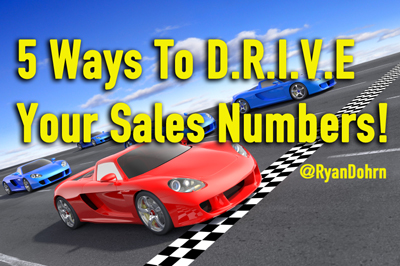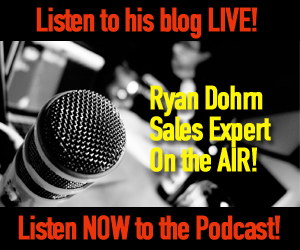
To win the Daytona 500 is one stop on your quest toward auto racing greatness. To win is more than just going fast. It requires a plan. Perhaps you think that auto racing is just a lot of circles at a fast speed. Nope. Everything from tire pressure to the air temperature contributes to crossing the finish line first. Race crews test for days and days to get their settings just right. There is a very specific plan for each race and each race track. As I travel and teach ad sales training workshops I am seeing more and more salespeople that are going fast in circles and not realizing that their lack of a plan is costing them race after race. Or, more precisely deal after deal. Let’s use the acronym D.R.I.V.E. to focus in on a potential plan for sales success.
1. The “D” in D.R.I.V.E. stands for Differentiate. You need to differentiate your product quickly from all others in the sector. Price will always become the deciding factor if two products seem similar. As a salesperson you need to work very hard to show the unique differences between your product and your competition. This is especially important if your product is more expensive than the competition. You need to do this while prospecting, hosting sales calls, closing deals and when retaining your advertiser. You need to create a clear and stark difference between you and your competition. Create an apples to salmon comparison and don’t allow an apples to apples comparison to exist in your potential advertiser’s mind.
2. The “R” in D.R.I.V.E. stands for Run. You need to run and not walk in today’s competitive sales environment. Today your advertisers are not willing to give you much time. Many ad sales training companies will tell you that you need to walk before you can run. Not me. Run. You need to run or you will lose to those that do. Ask yourself this question… Besides their family, what do most advertisers value above all else? Most of your prospective advertisers value their time above nearly all else in their life. Here is the actual issue. You are seen by most prospective advertisers as a time stealing sales person. You promise to be brief and then you show up with a 30 minute Power Point. So, cut to the chase. Promise to not waste their time. Then, don’t. I am often criticized for this philosophy because so many sales professionals rely on relationship building to secure deals. Don’t get me wrong, I am all about building relationships. There is just not enough time in most sales environments to create the relationships required to close a deal quickly. Very rarely do I come across a Sales Manager that says to his sales team, “I am going to give you 12 months to build relationships with your advertisers. I need no sales for the next 12 months.” Because of this you need to RUN! Consultative selling is not dead. You just need to speed up the process. Go to your next meeting prepared to present great ideas. Do not wait for the meeting to then go back to the office to come up with a good idea. Be prepared to run with great ideas that can be tweaked on the fly.
3. The “I” in D.R.I.V.E. stands for Invest. Invest in your next meeting with serious and solid preparation. Consultative selling is fine, but that often means you gather information in meeting #1 and then prepare a proposal for meeting #2. Then you chase the advertiser for weeks. Be prepared to come to the meeting with great ideas. The days of walking into a meeting to gather information from a advertiser are gone. This approach is dead. Begin your research with LinkedIn, the internet or other industry resources. Create three scenarios or ideas that you feel your prospective advertiser might like. Mention to the prospective advertiser that you spent time preparing for the meeting and have some great ideas to share. Then invent and tweak your ideas/proposal on the fly. Come prepared with ideas, options and pricing variables. Get buy in on the spot. My successful advertisers will build a proposal in front of the advertiser on their iPad or a piece of paper and get the ball rolling. Or, create pricing packages in advance based on common buying scenarios from past customers. Stop thinking your product is too complex for this approach. Or, you have to many media options. Be prepared to run scenarios that show potential savings or increases in productivity. Sure, you might guess wrong, but you will gain serious respect from a prospective Advertiser for the hard work. Preparation is key to your sales success. INVEST in the time it takes to come to sales call prepared.
4. The “V” in D.R.I.V.E. stands for Value. Value is everything in sales. If you bring no value to the prospective Advertiser you bring nothing to the Advertiser. There are three main things that most business people want. They want to save time. They want to save money. And, they want to make money. Sure I am being generic because each product or service is unique, but you should get my point here. You need to quickly prove what value you bring to the table. Once you have identified the value you offer then you need to focus on the sales call itself. Cut to the chase and drive home value with your talk or presentation. Many ad sales training programs miss this important point. Because we know that customers do not buy when they do not understand, you need to sell the total value you have to offer them in your visuals and sales chatter. Think more like a teacher than a sales rep. Break your thoughts into simple points. Remove the fluff. Keep it simple. Prove to them the value your ideas bring to their business. Proving value also weaves nicely with ROI. Value and showing return on investment are critical. All to often sales people focus on features and not their value proposition. A great example is a washing machine sale. If I only focused on the fact that a washing machine cleans your jeans the buyer might miss out on the fact that the new machines are super efficient, so they save you power, water and ultimately money. Plus, as an added bonus, you are doing your small part to help the environment. See… so much more than just clean jeans.
5. The “E” in D.R.I.V.E. stands for End Game. Establish a follow-up protocol so that your end game is crystal clear. This is the most important part of the D.R.I.V.E. sales process. At the point in the sales meeting when the advertiser says they need to “think about it” or “take the idea to the boss for approval” you need to establish a follow-up protocol. Sure you can try all the tricks taught in sales training workshops. Or, you can get real and understand that VERY often you will need to follow-up with a customer. You CAN NOT leave the follow-up protocol to the customer or you are dead. First, validate that the customer loves your idea/product/proposal. Then, use your phone to set your follow-up meetings and get the customer on your calendar. Invite them via your calendar to the meeting via email. Promise to not be a “typical” sales rep that will call them 1,000 times if they set the next meeting. However, do promise to call at the given time you agree upon and DO NOT miss the call. Try three times to establish a follow-up meeting before you give up. If the customer will not set a follow-up meeting you need to ask yourself if you actually have buy in on your idea/product/proposal. It critical that you understand that your follow-up process must adhere to what I like to call the “Magic 48 Hour Sales WindowTM .” What do I mean by that. You have approximately 48 hours to re engage the advertiser or risk losing them. Prospects tend to lose focus in 48 hours or less. So, book your follow-up within 48 hours. A week is a common request. Nope. Don’t fall for that. 48 hours. Trust me friends. 48 hours. This is why I do not pitch new sales proposals on a Friday. Be on the lookout for my eBook called, the “Magic 48 Hour Sales Window™ “ coming out soon.
Ok, let’s wrap up. Any plan is better than no plan. Think about the components of my D.R.I.V.E. sales plan and figure out ways to adjust your sales plan.
1. The “D” in D.R.I.V.E. stands for Differentiate. You need to differentiate your product quickly from all others in the sector.
2. The “R” in D.R.I.V.E. stands for Run. You need to run and not walk in today’s competitive sales environment.
3. The “I” in D.R.I.V.E. stands for Invest. Invest in your next meeting with serious and solid preparation.
4. The “V” in D.R.I.V.E. stands for Value. Value is everything in sales. If you bring no value to the prospective Advertiser you bring nothing to the Advertiser.
5. The “E” in D.R.I.V.E. stands for End Game. Establish a follow-up protocol so that your end game is crystal clear. I am here to help with sales coaching and sales training for media and tech companies large and small. I have trained over 3,000 salespeople in 7 countries. I actively sell each and every day products and services beyond myself. My challenge to you… What will you do different this week to improve your sales?
— Ryan
Ryan Dohrn is an award winning ad sales coach and offers ad sales training to thousands of media sales executives each year. He is also an international motivational speaker and the author of the best selling sales book, Selling Backwards. Ryan is the President and founder of Brain Swell Media, a boutique sales training and sales coaching firm with a detailed focus on sales training and coaching for media and technology companies. He is also the owner and Publisher of SalesTrainingWorld.com an online portal for sales training success.

